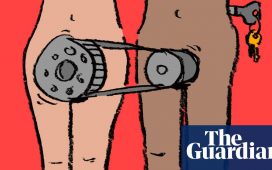Are you hankering for a hug, or horrified at the prospect of physical closeness? From Monday, people in England will officially be allowed to touch each other again. After a year of fist bumps, elbow rubs and hails across garden walls, it feels like a symbolic step back towards normality.
Yet with the spread of new variants, increasing coronavirus cases in some parts of the country, and much of the population still not fully vaccinated, some may be questioning whether they actually want to hug their neighbours, or shake hands with strangers again. Besides, there are so many other forms of social greeting to choose from now, from Boris bumps to spoon hugs. So which one should you choose?
“The key thing is not which of these things you do, but what the likelihood of one of you being infected is, and the likelihood of one of you or someone they are close to [ie live with] becoming seriously ill if they are infected,” says Prof Lucy Yardley, a member of the government’s Sage committee, and an expert in health behaviour change at the University of Bristol.
There are other things to consider too, such as the amount of time you spend touching, whether you’re indoors or outdoors, and the amount of joy you derive from the interaction. Here is an expert guide to post-lockdown social greetings.
Traditional handshake: medium risk – less if both people have washed hands very recently.

The handshake can be traced as far back as ancient Greece, and may have evolved as a gesture of peace by demonstrating that neither party was holding a weapon. But now we’ve got used to not shaking hands (and most of us aren’t routinely carrying a dagger), is this really a tradition we want to return to?
Hands are riddled with bacteria and viruses and are a known vector for the transmission of infectious diseases. Even after handwashing, four in five of us retain some disease-causing bacteria on our skin. Hand gel, or washing with soap for as long as it takes to hum the Happy Birthday song help to eliminate this risk, but is anyone still doing this?
Covid-19 isn’t the only risk. “If they didn’t wash their hands after they went to the toilet, it’s also faecal organisms – and just saying the words ‘faecal organisms’ makes you recoil slightly,” says Prof Cath Noakes of the University of Leeds, another Sage member. If ambushed, you could sanitise with hand gel immediately afterwards. Though one should be discrete about this to avoid appearing rude.
Bear hug: high risk.
Physical greetings bring you into close proximity with other humans, by their very nature. Touch is one means of transmitting Covid, but the main way it spreads is through breathing the same air. “With hugging, you’re within the region where you’re going to potentially breathe each other’s breath,” says Noakes. This risk can be reduced by wearing masks, and by turning your heads in opposite directions. A brief outdoor hug is also far less risky than a prolonged cuddle indoors, followed by a nice cup of tea in an unventilated room.
Also worth considering is the emotional reward you get from various types of physical contact. Noakes says: “You hug people you’re close to and you care about, and you value that emotional thing from a hug, whereas a handshake, you kind of do it because it seems like the polite thing to do, and you’re usually doing it to a stranger.”
Awful auntie: extremely high risk – particularly if the kiss is a sloppy one.

“A slobbery kiss involves direct transfer of saliva, and we know the virus can be in your saliva,” says Noakes. You’d hope your auntie, uncle, or anyone other than your partner wouldn’t be going anywhere near your mouth – but even if that saliva was deposited on your cheek, you might wipe it off with your hand, and then transfer it to your nose or eyes by rubbing them. This doesn’t just apply to Covid, but to other viruses and bacteria as well. Open-mouthed kisses are more risky still, because they transfer more saliva.
Even so, the risks associated with all forms of physical greeting hinge on both people’s vaccination status; the amount of time they spend in close contact with other people (through work, for example); whether either is close to someone who is vulnerable to infection; and local infection rates where you live. “If you are both fully vaccinated, neither of you is vulnerable to infection or close to someone vulnerable to infection, and infection levels in your area are low then all these activities are low risk – go ahead!” Yardley says.
La bise: safer, particularly if air-kissing from a distance.

Air-kissing usually brings you into the same breathing space, but your heads are generally facing in opposite directions. Provided you don’t physically touch each other’s cheeks, this can be a relatively low-risk form of greeting – although there’s always the chance you’ll mistime your kisses, and accidentally land one on the lips. Take care.
Spoon hug: medium-high risk – lower if there’s a big height difference.

Hugging from behind is a good strategy for grandparents wanting to hug their grandchildren, as their faces are kept well apart. Similarly, a child hugging an adults’ legs avoids face-to-face contact. However, for adults hugging other adults, the risks are higher. “If you’re the same height, there’s that one person’s breath over the other person shoulder problem,” says Noakes.
Cruise tap: low risk – if hands are clean, and you step away afterwards.
As an alternative to the hand shake, the fist bump – or its even safer relation, the cruise tap (where only two knuckles briefly touch each other) – has the advantage of avoiding contact with the palmar surface of the hand, which tends to be dirtier. According to a study published in the Journal of Hospital Infection in 2013, fist-bumping reduced the transmission of bacteria by about four times, compared with shaking hands. The total contact time of the handshake was also nearly three times longer.

However, a more recent study, which analysed the transfer of methicillin-resistant Staphylococcus aureus (MRSA) from contaminated hospital patients to researchers wearing a sterile glove, found that the transfer of germs was similar between a fist bump and handshake. Cruise-tapping transferred half the number of bacteria – but was harder to perform, particularly for those with reduced coordination or vision. For the well-coordinated, it is a pretty safe option, particularly if you’ve recently washed your hands, and you stay at arm’s-length.
Boris bump: low risk – especially if brief, and both parties turn their heads away as they do it.

If anyone had suggested elbow-rubbing as a standard form of social greeting back in 2019, you’d have been forgiven for thinking they were a member of Monty Python. However, Boris Johnson has normalised bumping elbows with members of the public, and the habit seems to be contagious. A No 10 source explained that the guidelines on distancing emphasised “the benefits of being side on rather than making contact with people face to face”, as usually happens with an elbow bump. Whether this greeting will persist post-pandemic remains to be seen.














